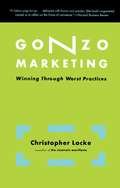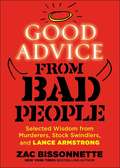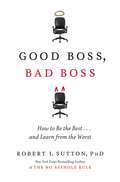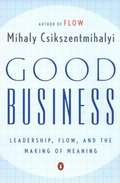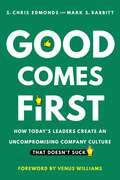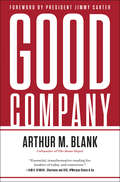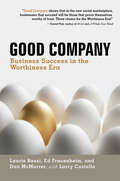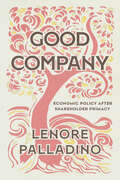- Table View
- List View
Gong: Resonating Conversational Insights
by Alison Wood Brooks Trevor SpelmanIn 2015, Amit Bendov was struck by a realization about a new technology that might be able to transcribe musical notation in real-time, which eventually became known as Gong. Gong's business proposition was simple: provide software that automatically captures, understands, and analyzes written and spoken sales conversations (not music) to help sales teams sell more effectively. It was a compelling idea with the potential to create significant value for its users. There were, however, many questions. Could the technology live up to its promises? What could salespeople learn from their own conversations and from the best - and worst - salespeople among them? Could leveraging conversational insights make a measurable impact on a company's bottom line? And how could Gong defend against competitors, both now and in the future?
Gonzo Capitalism: How to Make Money in An Economy That Hates You
by Chris GuillebeauDiscover &“new paths to prosperity you never knew existed&” in this &“must-read guide to the new economy.&” (Ozan Varol, author of Awaken Your Genius) The traditional ways of earning a living are outdated, if not outright rigged. That&’s why a growing number of enterprising individuals are instead turning to the growing ecosystem of decentralized, fast-moving virtual markets to pursue a host of previously unheard-of ways to pay the bills. Join New York Times bestselling author Chris Guillebeau on a fascinating tour of this brave new world where novelty is currency, and the creators are in control. Along the way, you&’ll meet a colorful cast of renegades who are driving this money revolution, including: A teenager who earned more than $400,000 helping indecisive parents pick the perfect name for their newborn child The armchair pundits and pop culture enthusiasts making hundreds of dollars a day betting on everything from local elections to who will be next to be voted off Love Island via online &“prediction markets&”. A broke 29-year-old who bartered her way from a hairpin to a new house—twice—while gaining internet fame in the process. The gamers racking up digital currency by breeding virtual crabs in the metaverse. A remote worker who collects two six-figure salaries from simultaneously working two different jobs. Gonzo Capitalism is your field guide to the new rules of money, where any and everything is for sale. In it, you&’ll learn how capitalize on today&’s technology and platforms to turn your time, talents, and creativity into income—on your own terms.
Gonzo Marketing: Winning Through Worst Practices
by Christopher LockeA Harvard Business Review Top-10 Business Book of 2001Gonzo Marketing is a knuckle-whitening ride to the place where social criticism, biting satire, and serious commerce meet--and where the outdated ideals of mass marketing and broadcast media are being left in the dust. Invoking the spirit of gonzo journalism, Locke rails against business practices that treat customers like cattle, and urges marketers of all stripes to tap into Web-based communities, or "micromarkets," based on candor, trust, passion, and a general disdain for anything that smacks of corporate smugness. Gonzo Marketing shows how companies that support and promote these communities can have everything they've always wanted: greater market share, customer loyalty, and brand equity. Laced with Locke's inimitable wit and penetrating point of view, Gonzo Marketing is the raucous wake-up call that no one in business--from the trading-room floor to the boardroom--can afford to ignore.
Gonzo Wall Street: RIOTS,RADICALS,RACISM AND REVOLUTION: How the Go-Go Bankers of the 1960s Crashed the Financial System and Bamboozled Washington
by Richard E. FarleyA Simon & Schuster eBook. Simon & Schuster has a great book for every reader.
Good Advice from Bad People
by Zac BissonnetteGood Advice from Bad People is a daringly original humor book based on real quotes from murderers, stock swindlers, and other ne'er-do-wells. The world is full of people telling you how to live your life. Sometimes though, the advice-givers fall ever so slightly short themselves For instance:'The day you take complete responsibility for yourself, the day you stop making any excuse, that's the day you start to the top. ' O. J. Simpson, 1975'When you know what you are talking about, others will follow you, because it's safe to follow you. ' Lehman Brothers CEO Richard Fuld, 2006'I think the most important thing is restore a sense of idealism and end the cynicism. ' Future Illinois Governor Rod Blagojevich, 2002'It is easier to get into something than to get out of it. ' Donald Rumsfeld, 1974Bissonnette also includes risk management advice from the man who triggered the world's largest hedge fund collapse; a pair of #1 bestselling relationship experts who married each other and promptly divorced; and gay-prostitute-patronizing pastor Ted Haggard on how to build a marriage that will last a lifetime. The result will keep you smiling while you glean all the wisdom you need to build the life you want . . . if only you can follow it better than the people who gave it
Good Arguments: How Debate Teaches Us to Listen and Be Heard
by Bo Seo&“The rare book that has the potential to make you smarter—and everyone around you wiser.&” —Adam Grant Two-time world champion debater and former coach of the Harvard debate team, Bo Seo tells the inspiring story of his life in competitive debating and reveals the timeless secrets of effective communication and persuasionWhen Bo Seo was 8 years old, he and his family migrated from Korea to Australia. At the time, he did not speak English, and, unsurprisingly, struggled at school. But, then, in fifth grade, something happened to change his life: he discovered competitive debate. Immediately, he was hooked. It turned out, perhaps counterintuitively, that debating was the perfect activity for someone shy and unsure of himself. It became a way for Bo not only to find his voice, but to excel socially and academically. And he&’s not the only one. Far from it: presidents, Supreme Court justices, and CEOs are all disproportionally debaters. This is hardly a coincidence. By tracing his own journey from immigrant kid to world champion, Seo shows how the skills of debating—information gathering, truth finding, lucidity, organization, and persuasion—are often the cornerstone of successful careers and happy lives.Drawing insights from its strategies, structure, and history, Seo teaches readers the skills of competitive debate, and in doing so shows how they can improve their communication with friends, family, and colleagues alike. He takes readers on a thrilling intellectual adventure into the eccentric and brilliant subculture of competitive debate, touching on everything from the radical politics of Malcom X to Artificial Intelligence. Seo proves beyond a shadow of a doubt that, far from being a source of conflict, good-faith debate can enrich our daily lives. Indeed, these good arguments are essential to a flourishing democracy, and are more important than ever at time when bad faith is all around, and our democracy seems so imperiled.
Good Arguments: What the art of debating can teach us about listening better and disagreeing well
by Bo SeoAt a time when every disagreement turns toxic, world champion debater Bo Seo reveals the timeless secrets of effective communication and persuasion.When Bo Seo was 8 years old, he and his family migrated from Korea to Australia. At the time, he did not speak English, and, unsurprisingly, struggled at school. But, then, in year five, something happened to change his life: he was introduced to debating.Immediately, he was hooked. It turned out, perhaps counterintuitively, that debating was the perfect activity for someone shy and unsure of himself. It became a way for Bo not only to find his voice, but to excel socially and academically. He went on to win world titles with the Australian schools and Harvard University teams.But debating isn&’t just about winning or losing an argument: it&’s about information gathering, truth finding, lucidity, organization, and persuasion. It&’s about being able to engage with views you disagree with, without the argument turning toxic.Good Arguments shares insights from the strategy, structure and history of debating to teach readers how they might better communicate with friends, family and colleagues. Touching on everything from the radical politics of Malcom X to Artificial Intelligence, Seo proves beyond a shadow of a doubt that, far from being a source of conflict, good-faith debate can enrich our daily lives. Indeed, these good arguments are more important than ever at time when bad faith is all around, and our democracy seems so imperiled.&‘From two-time world champion debater Bo Seo, a thoughtful, instructive and eloquent meditation on the art of debate and why its central pillars - fact-finding, reason, persuasion and listening to opponents - are so valuable in today&’s alarming ecosystem of misinformation and extreme emotion. When Bo Seo&’s family immigrated from South Korea to Australia, he was a shy, conflict-averse eight year old who worried about being an outsider, and in &“Good Arguments,&” he recounts how debate not only helped him to cross language lines, but also gave him confidence and a voice of his own.&’ Michiko Kakutani, former chief book critic for The New York Times.
Good Boss, Bad Boss: How to Be the Best... and Learn from the Worst
by Robert SuttonIn his long-awaited follow-up to The No Asshole Rule, Robert Sutton reveals the actions of the best bosses and contrasts these with the mistakes of the worst, so that you can learn to become the great boss most people dream of having.The stark differences between what superb and lousy bosses do is backed up by piles of research, and Good Boss, Bad Boss blends this with true stories to contrast the best and worst moves bosses make when taking charge, making decisions and turning talk into action.If you are serious about becoming a skilled and compassionate boss, Good Boss, Bad Boss is the essential guide.
Good Boss, Bad Boss: How to Be the Best... and Learn from the Worst
by Robert SuttonFrom the New York Times bestselling author of The No Asshole Rule'I am frequently asked, "Tom, my brother/sister/friend is taking on a new leadership role. What should they read?" I always respond the same way, by recommending one and only one book: Bob Sutton's Good Boss, Bad Boss' - Tom Peters, New York Times bestselling author of In Search of Excellence.Good Boss, Bad Boss was inspired by the thousands of emails, calls and conversations that Robert Sutton received after publishing his bestseller The No Asshole Rule - he found that most of the stories and cries for help he received revolved around one central figure in every workplace: THE BOSS.Sutton's subsequent research showed that the success of every boss depended heavily on how well (or badly) they managed those they worked with and in Good Boss, Bad Boss he demonstrates this by weaving together the best psychological and management secrets with true stories, to reveal the mindset and moves of the best bosses, and contrasts them with the behaviour of the worst.If you want to understand how the best bosses think and act so that you can get better at your job or find a better boss to work for, Good Boss, Bad Boss has all the answers.
Good Boss, Bad Boss: How to Be the Best... and Learn from the Worst (Playaway Adult Nonfiction Ser.)
by Robert I. SuttonIf you are a boss who wants to do great work, what can you do about it? Good Boss, Bad Boss is devoted to answering that question. Stanford Professor Robert Sutton weaves together the best psychological and management research with compelling stories and cases to reveal the mindset and moves of the best (and worst) bosses. This book was inspired by the deluge of emails, research, phone calls, and conversations that Dr. Sutton experienced after publishing his blockbuster bestseller The No Asshole Rule. He realized that most of these stories and studies swirled around a central figure in every workplace: THE BOSS. These heart-breaking, inspiring, and sometimes funny stories taught Sutton that most bosses - and their followers - wanted a lot more than just a jerk-free workplace. They aspired to become (or work for) an all-around great boss, somebody with the skill and grit to inspire superior work, commitment, and dignity among their charges.As Dr. Sutton digs into the nitty-gritty of what the best (and worst) bosses do, a theme runs throughout Good Boss, Bad Boss - which brings together the diverse lessons and is a hallmark of great bosses: They work doggedly to "stay in tune" with how their followers (and superiors, peers, and customers too) react to what they say and do. The best bosses are acutely aware that their success depends on having the self-awareness to control their moods and moves, to accurately interpret their impact on others, and to make adjustments on the fly that continuously spark effort, dignity, and pride among their people.
Good Business
by Mihaly CsikszentmihalyiSince Mihaly Csikszentmihalyi published his groundbreaking bookFlowmore than a decade ago, world leaders such as Prime Minister Tony Blair and former U. S. President Bill Clinton, and influential sports figures like Super Bowl champion coach Jimmy Johnson have all been inspired by the book. In today's corporate upheaval, a new business paradigm is evolving. While many CEOs are being exposed for their greed, truly visionary leaders believe in a goal that benefits themselves as well as others. They realize that it is their vision and "soul" that attract loyal employees willing to go above and beyond the call of corporate duty. And their employees are realizing the same thing. While 80 percent of adults claim they'd work even if they didn't have to, the majority of them can hardly wait to leave their jobs and get home. Good Businessstarts with the premise that this is an age in which business and work have replaced religion and politics as central forces in contemporary life. This audiobook reveals how business leaders, managers, and employees can find their "flow" and contribute not only to their own happiness, but also to a just and evolving society. It identifies the factors crucial to the operation of a good business: trust, the commitment to fostering the personal growth of employees, and the dedication to creating a product that helps mankind. Good Business is a must-listen for anyone who values the positive contributions of individuals in the changing world of business.
Good Business
by Mihaly CsikszentmihalyiSince Mihaly Csikszentmihalyi published the groundbreaking Flow more than a decade ago, world leaders such as Tony Blair and former President Clinton, and influential sports figures like Super Bowl champion coach Jimmy Johnson have all been inspired by the book. In today's corporate upheaval, a new business paradigm is evolving. While many CEOs are being exposed for their greed, truly visionary leaders believe in a goal that benefits themselves as well as others. They realize that it is their vision and "soul" that attract loyal employees willing to go above and beyond the call of corporate duty. And their employees are realizing the same thing: while 80 percent of adults claim they'd work even if they didn't have to, the majority of them can hardly wait to leave their jobs and get home.Good Business starts with the premise that this is an age in which business and work have replaced religion and politics as central forces in contemporary life. The book reveals how business leaders, managers, and even employees can find their "flow" and contribute not only to their own happiness, but also to a just and evolving society. It identifies the factors crucial to the operation of a good business: trust, the commitment to fostering the personal growth of employees, and the dedication to creating a product that helps mankind. Good Business is sure to become a must-read text for anyone who values the positive contributions of individuals in the changing world of business.
Good Business: An Entrepreneur's Guide to Creating a Better World
by Lilly TenchGood Business: An Entrepreneur's Guide to Creating a Better World is an illustrated guide that takes readers through the complicated but exhilarating landscape of social enterprise businesses that are changing the world.A social enterprise is a different kind of business, one that uses a market-driven approach to address a social or environmental problem such as poverty, environmental damage, or resource scarcity, with the dual goals of helping humanity and building a profitable business.With a climate crisis, a growing population, and diminishing natural resources, the need for socially-minded innovators is greater than ever. Good Business is designed to be a practical guide and tool for innovators, entrepreneurs, and dreamers who are attempting to navigate the complicated business models required for social enterprises.
Good Business: Exercising Effective and Ethical Leadership
by Don Mayer James O'TooleThis illuminating and practical collection of essays addresses the increasingly important topics of corporate ethics, social responsibility, and sustainability in the context of effective global business strategies. Instead of condemning business, or exhorting corporate leaders to "do good," the authors deal with the "hot button" issues of our time in a cool and rational manner, seeing them as opportunities rather than as problems. As the authors illustrate, there is no necessary trade-off between business leaders doing the right thing, on one hand, and the profitable thing, on the other. They demonstrate that ethics is not peripheral, or in addition to, the central concerns of business. To the contrary, ethics and good citizenship are at the heart of all good business strategies, decisions, and organizational cultures. These essays offer useful examples of how executives can create strategies and cultures that are, both and at the same time, ethical and effective--the essence of GOOD BUSINESS. A PUBLICATION OF THE INSTITUTE FOR ENTERPRISE ETHICS Daniels College of Business, University of Denver
Good Business: Policy to Unlock Companies’ Benefit for Society (Research for Policy)
by Marthe Hesselmans Catrien Bijleveld Bart Stellinga Ramy El-Dardiry Danique FrançoisThis open access book shows how governments can motivate companies to make a positive impact on society and why this is necessary in light of today&’s pressing social, economic and environmental challenges and transitions. It shows obstacles companies face in conducting socially responsible business. Focusing on government-business relations in the Netherlands, the book also exposes key policy bottlenecks: the tendency of the Dutch government to hold on to the status quo and shield incumbent firms through tax breaks and lax enforcement. There is a real risk of policies that pamper business: it hampers companies that offer societal innovations for instance for health, education or the labour market. We also show how policies can better capitalise on the innovative qualities of entrepreneurship. Effective government policy makes it worthwhile for companies to alter their business model so that their products, services and production processes benefit society. Our recommendations address the role of government, consumers, financiers and companies themselves. While this work focuses on the Netherlands, it tackles questions that countries face worldwide on how to minimise harmful business conduct and maximise good business solutions. This makes the book broadly relevant to policy makers, business leaders and researchers grappling with the impact of business on society today.
Good Business: The Talk, Fight, Win Way to Change the World
by Bill NovelliAn inspiring and practical look inside the mind of Bill Novelli, one of the founders of social marketing, Good Business challenges all of us to change the world for the better and is a blueprint for tackling today's critical issues.From his humble beginnings selling soap in a sales training program to his rapid rise in the fast-paced New York advertising scene, Bill Novelli was well on his way to becoming a leader in the hypercompetitive business world. But it wasn't long before he became disillusioned with the drive for profits at any cost. He knew that his marketing skills made those companies successful, but what good did that success do for the world? That question sent him on a career path that involved taking the marketing and communication tactics long used by big businesses and applying them to social change. He found that this strategy was not only good for the world but also good for business. In Good Business, Novelli begins with his early career success in Mad Men–era marketing, which left him feeling unfulfilled. He describes the process of changing career trajectory: how he helped reposition the Peace Corps; built Porter Novelli, a global PR agency for social impact; fought the Tobacco Wars; and became CEO of AARP, the largest nonprofit in America. Drawing practical lessons and principles from play-by-play stories of his experiences in large and small organizations, Novelli deploys his characteristic wit to stress the importance of building and maintaining connections with people—and engaging them in the cause. Good Business, which is part behind-the-scenes look at crafting social and health policy, part inspirational guide, proves that you can do well (creating economic and financial success for yourself and your company or organization) by doing good (helping to solve the world's and society's major problems). Throughout the book, Novelli shows that you can make a positive social difference regardless of what business you are in or where you are in your career. Readers will come away with the message that anyone who wants to have a positive impact on the world can do it right now from where they are—or can be inspired by Novelli's story to make the leap to somewhere they can.
Good Chaps: How Corrupt Politicians Broke Our Law and Institutions - And What We Can Do About It
by Simon KuperThe 'Good Chaps' theory holds that those who rise to power in the UK can be trusted to follow the rules and do the right thing. They're good chaps, after all. Yet Britain appears to have been taken over by bad chaps, and politics is awash with financial scandals, donors who have practically bought shares in political parties, and a shameless contempt for the rules.Simon Kuper, author of the Sunday Times Top Ten bestseller Chums, exposes how corruption took control of public life, and asks: how can we get politicians to behave like good chaps again?
Good Charts: The HBR Guide to Making Smarter, More Persuasive Data Visualizations
by Scott BerinatoDataviz-the new language of businessA good visualization can communicate the nature and potential impact of information and ideas more powerfully than any other form of communication.For a long time "dataviz" was left to specialists-data scientists and professional designers. No longer. A new generation of tools and massive amounts of available data make it easy for anyone to create visualizations that communicate ideas far more effectively than generic spreadsheet charts ever could.What's more, building good charts is quickly becoming a need-to-have skill for managers. If you're not doing it, other managers are, and they're getting noticed for it and getting credit for contributing to your company's success.In Good Charts, dataviz maven Scott Berinato provides an essential guide to how visualization works and how to use this new language to impress and persuade. Dataviz today is where spreadsheets and word processors were in the early 1980s-on the cusp of changing how we work. Berinato lays out a system for thinking visually and building better charts through a process of talking, sketching, and prototyping.This book is much more than a set of static rules for making visualizations. It taps into both well-established and cutting-edge research in visual perception and neuroscience, as well as the emerging field of visualization science, to explore why good charts (and bad ones) create "feelings behind our eyes." Along the way, Berinato also includes many engaging vignettes of dataviz pros, illustrating the ideas in practice.Good Charts will help you turn plain, uninspiring charts that merely present information into smart, effective visualizations that powerfully convey ideas.
Good Clinical Practice in der Gefäßchirurgie
by E. Sebastian Debus Reinhart Grundmann Julika HeilbergerIn dem Buch werden Zielparameter definiert, die im Rahmen eines Qualitätsmanagementsystems unter optimalen Bedingungen erreichbar sind, sowie Strukturen und Prozesse dargestellt, die der Patientensicherheit dienen. Die Ergebnisqualität wird beispielhaft anhand der drei häufigsten im Krankenhaus behandelten gefäßchirurgischen Erkrankungen (extrakranielle Karotisstenose, abdominelles Aortenaneurysma, periphere arterielle Verschlusskrankheit) analysiert. Die Kapitel zur Prozess- und Strukturqualität sowie zur Patientensicherheit sind für alle chirurgischen Fächer in gleicher Weise relevant und berücksichtigen zum Beispiel die Handhabung von Ablaufpfaden und Checklisten, den Personalschlüssel auf Station, die Organisation der Intensivstation oder das Fehlermanagement.
Good Comes First: How Today's Leaders Create an Uncompromising Company Culture That Doesn't Suck
by S. Chris Edmonds Mark S. BabbittDiscover the practical, step-by-step guide to creating a workplace culture that&’s better for employees, customers, and stakeholders—and your company&’s bottom line. For decades, talented people have tolerated old-school leaders who put results before respect, toxic company cultures, and workplaces that suck. But those days are over, and if leaders want to attract and retain the best employees—while improving productivity, customer service, employee satisfaction, and profits—it&’s time for them to create work cultures where good comes first. The problem is that because the corporate world has too often been driven primarily by results, we seldom ask leaders to change their work cultures. Even if we did, most leaders don&’t know how. This book provides the actionable inspiration and practical direction needed to make that change happen. In Good Comes First, S. Chris Edmonds and Mark S. Babbitt go beyond theoretical advice, using their combined 50 years of experience to present proven strategies for creating purposeful, positive and productive work cultures. Cultures where good comes first for employees, customers, leaders, and stakeholders—and where improved business outcomes quickly follow. In these pages, readers will learn to: Appreciate why a good comes first culture is a business imperative – especially for younger generations. Distance yourself from the competition that maintains its undefined work culture (one that most likely sucks). Identify what &“good&” means for your company in today&’s business climate – and in the future of work. Define your uncompromising work culture as you build a foundation of respect AND results. Formalize your team&’s servant purpose so that everyone understands how what your team does improves lives and communities. Specify respectful behaviors, so your desired values are observable, tangible, and measurable. Align your entire organization to your desired work culture – where good comes first every day. Assess the quality of your current work culture by measuring and monitoring how well your leaders and your executive team demonstrate your servant purpose, valued behaviors, strategies, and goals. Hold everyone accountable for both respect and results through modeling, celebrating, measuring, coaching, and mentoring leaders and team members. Implement real, needed change – and quit &“thinking&” and &“talking&” about change (but never really get change started). Become a change champion while creating a lasting legacy as a business leader. Build a team of good people doing good work in a good company. What&’s more, Good Comes First shows you where potential barriers to success hide—and how to push through them—and illuminates the moments when you&’ll feel the most satisfaction and gain the most traction. After reading this book, you will see that when done right, change is not only possible—it&’s practical, powerful, and profitable. And you will realize that you are the right person, at the right time, to make that change happen.
Good Communication that Blocks Learning
by Chris ArgyrisThe new but now familiar techniques of corporate communication--focus groups, surveys, management-by-walking-around--can block organizational learning even as they help solve certain kinds of problems. These techniques do help gather simple, single-loop information. But they also promote defensive reasoning by encouraging employees to believe that their proper role is to criticize management while the proper role of management is to take action and fix whatever is wrong. Managers focus so earnestly on "positive" values--employee satisfaction, upbeat attitude, high morale--that it would strike them as destructive to make demands on employee self-awareness. Yet employees dig deeper and harder into the truth when the task of scrutinizing the organization includes looking at their own roles, responsibilities, and potential contributions to corrective action.
Good Company
by Arthur M BlankFeaturing an introduction by President Jimmy CarterThe Home Depot cofounder and owner of the NFL's Atlanta Falcons and MLS's Atlanta United shares a vision and a roadmap for values-based business. Arthur M. Blank believes that for good companies, purpose and profit can-and should-go hand in hand. And he should know. Together with cofounder Bernie Marcus, Blank built The Home Depot from an idea and a dream to a $50 billion-dollar company, the leading home improvement retailer in the world. And even while opening a new store every 42 hours, they never lost sight of their commitment to care for their people and communities. In fact, in 2001, The Home Depot was voted America's most socially responsible company. Blank left The Home Depot that same year with a burning question: Could the values and culture that made that company great be replicated? Good Company takes readers inside the story of how he did just that-turning around a struggling NFL team, rebooting a near-bankrupt retail chain, building a brand-new stadium, revitalizing a blighted neighborhood, launching a startup soccer club, and more. "When good companies put the wellbeing of their customers, their associates, and their communities first, financial success will follow," Blank writes. "The entrepreneurs and business leaders of today and tomorrow have an extraordinary opportunity: to prove that through upholding values we can create value-for the company, for the customer, and for the community."
Good Company: Business Success in the Worthiness Era
by Laurie Bassi Ed Frauenheim Dan McMurrer Larry CostelloWe're losing patience with bad companies. We're fed up with the greed of Goldman Sachs, sickened by BP's pollution, tired of tainted food, tightfisted employers, and phony "corporate social responsibility." And Laurie Bassi and her co-authors have news: the "bad boy" days are over. We're at the dawn of the Worthiness Era, when doing the right thing is no longer optional--it's the key to success. And they've got the data to prove it. Good Company lays out the convergence of social, economic, and political forces-- ranging from the explosion of online information sharing to the emergence of the ethical consumer and the rapid expansion of the green market--that are ushering in this new era. Moreover, the authors prove the connection between good corporate behavior and the bottom line with their Good Company Index. Using publicly available information as well as original research, the Good Company Index evaluates each of the Fortune 100 companies as an employer, seller, and steward and then gives it a final grade. Among the surprising findings: only two Fortune 100 companies get an A, while a number of highly respected companies get a C or worse. Overall, companies in the same industry with higher rankings on the index consistently outperform their competitors. And this is not some academic exercise: the authors have used the principles of the index at their own investment firm to deliver market-beating results. Using a host of real-world examples Bassi and company carefully explain each aspect of corporate worthiness, offering companies a guide to what it now takes to win customer loyalty. Good Company moves the debate about corporate citizenship from the realm of faith to the realm of facts, showing it's no longer a question of ethics or virtue: it's a matter of survival.Winner of the gold medal in the Business/Leadership category of the 2012 Nautilus Book Awards and Choice Magazine's Outstanding Academic Title Award.
Good Company: Economic Policy after Shareholder Primacy
by Lenore PalladinoOn the faulty intellectual origins of shareholder primacy—and how policy can win back what’s been lost. In an era of shareholder primacy, share price is king. Businesses operate with short-term goals to deliver profits to shareholders, enjoying stability (and bonuses) in the process. While the public bemoans the doctrine for its insularity and wealth-consolidating effects, its influence over corporate governance persists. Good Company offers an exacting argument for why shareholder primacy was never the right model to follow for truly understanding how corporations operate. Lenore Palladino shows that corporations draw power from public charters—agreements that allow corporations to enjoy all manner of operational benefits. In return, companies are meant to innovate for the betterment of the societies that support them. However, that debt—increasingly wielded for stock buybacks and shareholder bonuses—is not being repaid. Palladino theorizes a modern corporation that plays its intended role while delivering social and economic good in the process and offers tangible policy solutions to make this a reality. Good Company is both an expert introduction to the political economy of the firm—as it was, as it is, as it can be—and a calibrating examination of how public policy can shape companies, and societies, for the better.
Good Company: How to Build a Business without Losing Your Values
by Julietta Dexter'What a joy! Inspiring and powerful.' -- Ruby WaxIn a highly competitive world, many think business success means being ruthless: maximising short-term return for shareholders, cutting overheads, crushing competition, and expanding at an exponential pace. Nothing says this more than Silicon Valley with its macho mantras like 'Move fast and break things' (Facebook) or 'We're a team not a family' (Netflix). But this model is looking increasingly flawed.What if there were another more compassionate way? Julietta Dexter believes there is. In this powerful and hopeful book, the award-winning CEO of The Communications Store explains how she built one of the world's most respected PR & communications companies without compromising her morals and without screwing over her staff or her clients. Highlighting a new paradigm for business, she explains why profit should be just one consideration among several, and why honesty, reliability and diversity are the best foundations for long-term success.


